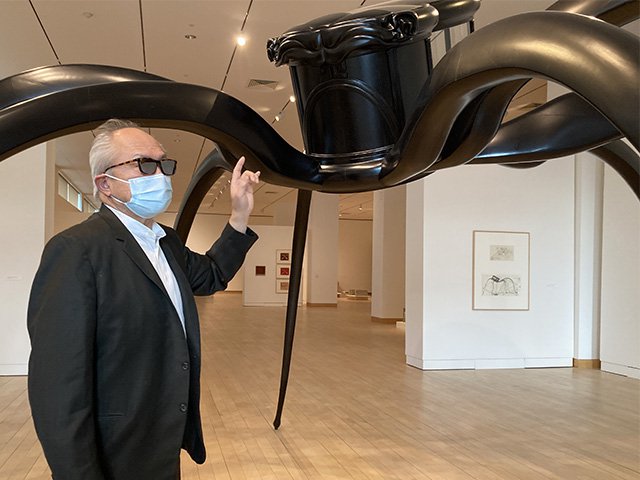Mel Chin arrives at the Madison Museum of Contemporary Art on an unseasonably warm March day wearing a dark suit, dark shoes and dark glasses, looking somehow both dapper and nondescript. The artist is in town to deliver the Stephen Fleischman Lecture at MMoCA and this afternoon is giving me a tour of his exhibit, There’s Something Happening Here, which runs through July 31.
This is the kind of pleasurable surprise that sometimes falls into your lap when you write for a newspaper. It’s the sort of offer you should just say “yes” to, no matter how too-busy you think you are. It’s like having the author of a novel come to your book group, or Euclid explain triangles.
Chin borrows a mask from the front desk — masks are still “on” inside the museum even though Dane County has lifted its mandate — and we head up the museum’s dramatic white stairs toward a display at the top.
There, the original drawings from his graphic novella 9-11/9-11 are stacked in two columns, framed in stainless steel, recalling the Twin Towers themselves. The drawings have never been displayed in this way before (it’s the brainchild of MMoCA curator Leah Kolb). “Maybe this is the right way to do it,” Chin says.
As we head into the second floor gallery, Chin stops at the looming spider-like sculpture that confronts/greets/towers over the visitor upon entering. It is called “Cabinet of Craving,” and without Chin at my side, I would probably cruise right by with an internal “hmm” and a shrug.
But as Chin unveils the layers of meaning behind the piece, it makes sense. The piece began as an homage to the large sculptures of Louise Bourgeois, who used spider shapes in her work, as well as glass display cases. One of those is here too, a glass case up high in the spidery body, atop graceful lacquered oak legs and carved Queen Anne’s style feet that turn the spider into a piece of furniture. The glass case houses a tea set.
Sometimes art “creates a question,” says Chin. In this case it’s “What kind of teapot and what is it on?” Both a simple question, and a complex one.
The 1843 English bone china tea set on a silver tray represents the English desire for tea, the Chinese desire for silver, trade imbalances, the English illegally introducing opium to China, the Opium Wars, the ensuing crisis of addiction — all contributing to the rise of the British Empire and the breakdown of China. It was a history so painful and shameful it was seldom discussed, Chin says, and he thought art was the way to begin.
While at first “Cabinet of Craving” might seem removed from current events, it’s “the monster of addiction we are confronted with again now, with the fentanyl and opioid crisis,” Chin observes. “It dominates, in an attack position, it is ready to pounce, a nightmare that emerges from within household objects.”
The artist is soft-spoken yet deliberate as we wander through the gallery, explaining “how an idea or a way of being is always ripe for critique.” He stresses that his explanation of any work is not the only interpretation. Viewers have their own readings, and “Sometimes these bring you closer to the meaning — because art is a relationship of ideas.”
Ideas, while often at the heart of a Chin piece, also translate into action.
His Fundred initiative is a participatory project, based on a trip Chin took to New Orleans after Hurricane Katrina, “to help, not to make art,” he stresses. While there, he became concerned about the pervasiveness of lead poisoning, how it affects so many children, and the need for governmental action to pay for removing lead from our everyday environments.
Chin describes Fundred as “a drawing project,” and it is; everyone is invited to draw their own design on a blank $100 bill template. It’s also “a drive to transform policy” and value expression, especially children’s creativity.
The action evolved to bring families and kids in front of their congressional leaders to advocate for lead policies, including the Lead-Safe Housing for Kids Act of 2021.
The actual drawn Fundreds are headed for the “Fundred Reserve,” an elaborate, bank-like display at the Brooklyn Museum of Art, where the piece’s medium is cataloged as “paper, hemp twine, white oak, bronze, silk, brass, pigment, patina, Styrofoam, wood.”
“I conceived of this project,” Chin says. “But I’m only the delivery person of their voices.”
By the numbers
Years of Chin’s art the MMoCA retrospective encompasses: 43
Dimensions of “Cabinet of Craving”: 9 x 14 x 14 feet
Numbers of Chinese people addicted to opium by 1906: 13.5 million and an estimated 27 percent of the country’s men
Fundreds that have been drawn so far: 500,000+
Fundreds drawn for the MMoCA exhibit to date: 2,500
Where you can see Mel Chin’s Stephen Fleischman Lecture: tinyurl.com/chinlecture


